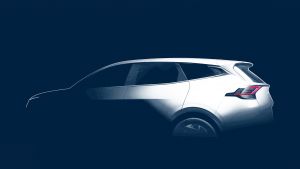A
Alex Ingram
Guest
An all-new fifth-generation version of the Kia Sportage will be revealed in July and, for the first time, it will be designed with a model specific to the European market. Teased in these new images, Kia promises a radical visual overhaul for the Sportage, which will look to shake up the family crossover sector as a new challenger for the Volkswagen Tiguan and Peugeot 3008.
“With the new Sportage, we didn’t simply want to take one step forward, but rather move to a completely different level within the SUV class,” claims Kia design boss Karim Habib.
The teaser images hint at a front end dominated by a large grille - the largest version of Kia’s ‘Tiger Nose’ grille yet. It will incorporate large C-shaped daytime running light signatures, while at the rear, prominent shoulders over the rear arches flow into the taillights, with a full-width LED light bar spanning the tailgate.

Kia has also teased the new Sportage’s interior, revealing that the dashboard will feature a vast curved display for both the digital instruments and the central infotainment system. It’s likely to be the same set-up as used in the recently released Hyundai Tucson, making use of two 10.25-inch displays.
As with the current Sportage, the next model will share much with the new Tucson, including its fundamental mechanical layout, its safety assist systems and its in-car tech.
Should the next Sportage make use of the Tucson’s full engine line-up, a choice of front- and four-wheel drive will be available. Electrification will feature heavily throughout the range, too; the Hyundai’s line-up kicks off with petrol and diesel engines that include a 48-volt mild-hybrid set-up.
The system, which is already offered on some engines in the current Sportage range, harnesses braking energy when slowing down and charges a small battery. This then deploys its charge to reduce the load on the engine under acceleration. The MHEV tech will be paired with the group’s Intelligent Manual Transmission, a manual gearbox that features an electronically controlled clutch to allow for in-gear, engine-off coasting.

The next step up the hybrid range will be a more traditional petrol-electric combination. A 1.6-litre combustion engine will team up with a 59bhp electric motor, for a combined output of 227bhp and 350Nm of torque. The hybrid will allow for short distances to be covered in electric mode alone, with the batteries charged either when coasting, or from the engine itself.
A plug-in model will offer the greatest potential for low fuel bills, while low tax rates will be a big incentive for company car users. The same 1.6-litre petrol engine will likely feature, but with a larger-capacity battery that should return a zero-emissions range of around 30 miles.
For the first time, the Sportage is likely to offer configurable suspension, thanks to the option of adaptive dampers. Also on the cards is a semi-autonomous driving system, allowing the Sportage to accelerate, brake and steer in lanes for short periods before needing intervention from the driver.
What will the new Kia Sportage have to beat? These are the best crossovers currently on sale...
Continue reading...
“With the new Sportage, we didn’t simply want to take one step forward, but rather move to a completely different level within the SUV class,” claims Kia design boss Karim Habib.
The teaser images hint at a front end dominated by a large grille - the largest version of Kia’s ‘Tiger Nose’ grille yet. It will incorporate large C-shaped daytime running light signatures, while at the rear, prominent shoulders over the rear arches flow into the taillights, with a full-width LED light bar spanning the tailgate.

Kia has also teased the new Sportage’s interior, revealing that the dashboard will feature a vast curved display for both the digital instruments and the central infotainment system. It’s likely to be the same set-up as used in the recently released Hyundai Tucson, making use of two 10.25-inch displays.
As with the current Sportage, the next model will share much with the new Tucson, including its fundamental mechanical layout, its safety assist systems and its in-car tech.
Should the next Sportage make use of the Tucson’s full engine line-up, a choice of front- and four-wheel drive will be available. Electrification will feature heavily throughout the range, too; the Hyundai’s line-up kicks off with petrol and diesel engines that include a 48-volt mild-hybrid set-up.
The system, which is already offered on some engines in the current Sportage range, harnesses braking energy when slowing down and charges a small battery. This then deploys its charge to reduce the load on the engine under acceleration. The MHEV tech will be paired with the group’s Intelligent Manual Transmission, a manual gearbox that features an electronically controlled clutch to allow for in-gear, engine-off coasting.

The next step up the hybrid range will be a more traditional petrol-electric combination. A 1.6-litre combustion engine will team up with a 59bhp electric motor, for a combined output of 227bhp and 350Nm of torque. The hybrid will allow for short distances to be covered in electric mode alone, with the batteries charged either when coasting, or from the engine itself.
A plug-in model will offer the greatest potential for low fuel bills, while low tax rates will be a big incentive for company car users. The same 1.6-litre petrol engine will likely feature, but with a larger-capacity battery that should return a zero-emissions range of around 30 miles.
For the first time, the Sportage is likely to offer configurable suspension, thanks to the option of adaptive dampers. Also on the cards is a semi-autonomous driving system, allowing the Sportage to accelerate, brake and steer in lanes for short periods before needing intervention from the driver.
What will the new Kia Sportage have to beat? These are the best crossovers currently on sale...
Continue reading...
